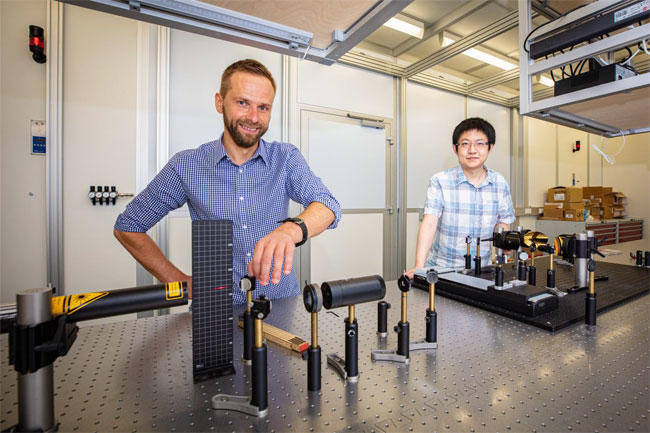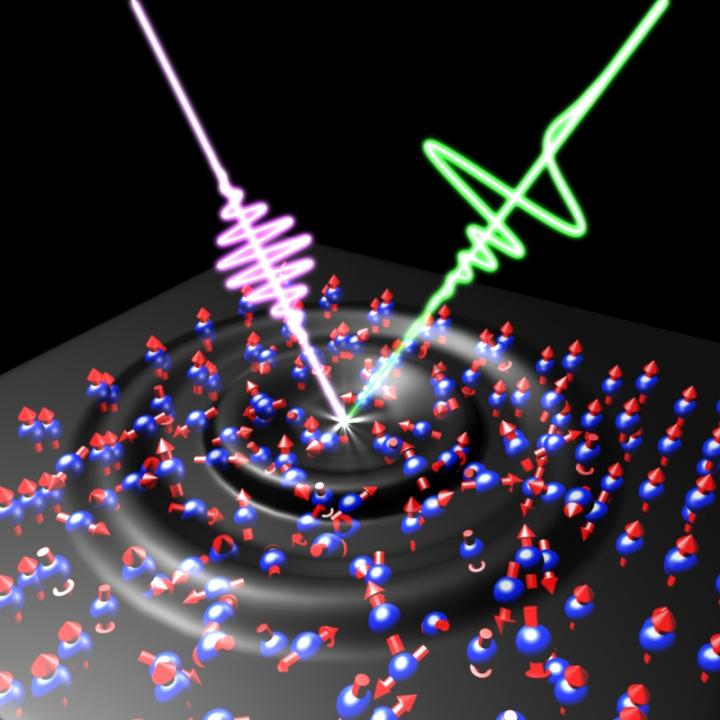Physicists have precisely measured the ultrafast change in a magnetic state in materials by observing the emission of terahertz (THz) radiation that accompanies such a change in magnetization. An international research team that included scientists from Bielefeld University, Uppsala University, the University of Strasbourg, the University of Shanghai for Science and Technology, Max Planck Institute for Polymer Research, ETH Zürich, and the Free University Berlin developed and tested the ultrafast magnetometry method.
The work could pave the way for spintronic research and technologies based on a purely acoustic and, where possible, heat-free, ultrafast control of magnetism.
A material’s magnetic state and its dynamics are of fundamental research interest, and are also at the core of several technologies. However, reliable access to magnetization dynamics in materials and devices on the ultrafast timescale and under realistic device-operation conditions remains a challenge.
“The actual challenge is to be able to detect such a magnetization change quickly and sensitively enough,” professor Dmitry Turchinovich from Bielefeld University, who led the research, said. “Our idea was to use the basic principle of electrodynamics.”

With their international colleagues, professor Dmitry Turchinovich (left) and researcher Wentao Zhang (right) demonstrate how the ultrafast change of magnetic states can be measured. Courtesy of Bielefeld University/M.D. Müller.
This principle states that a change in the magnetization of a material must result in an emission of electromagnetic radiation that will contain complete information on this change. If the magnetization in a material changes on a picosecond timescale, the emitted radiation will belong to the THz frequency range. This radiation, known as magnetic dipole emission, is weak and can be easily obscured by light emission that has originated elsewhere.
According to Bielefeld researcher Wentao Zhang, the team was able to isolate the precise magnetic dipole THz emission that was necessary to reliably reconstruct the ultrafast magnetization dynamics in encapsulated iron nanofilms, which the team used for its experiment.

The researchers were able to measure the magnetization dynamics in the iron nanofilm caused by ultrafast electronic and acoustic processes. Courtesy of Bielefeld University/W. Zhang.
The researchers sent very short pulses of laser light onto the iron nanofilms, causing them to demagnetize very quickly. They simultaneously collected the THz light that was being emitted during the demagnetization process. An analysis of this THz emission yielded the precise temporal evolution of a magnetic state in the iron film.
“It has already been known for some time that iron can demagnetize very quickly when illuminated by laser light,” Turchinovich said. “But what we also saw was a reasonably small, but a very clear additional signal in magnetization dynamics.
“This signal came from the demagnetization in iron — actually driven by the propagation of a very fast pulse of sound through our sample.
“Where did this sound come from? Very easy: When the iron film absorbed the laser light, it not only demagnetized, it also became hot. As we know, most materials expand when they get hot — and this expansion of the iron nanofilm launched a pulse of terahertz ultrasound within our sample structure.
“This sound pulse was bouncing back and forth between the sample boundaries, internal and external, like the echo between the walls of a big hall. And each time this echo passed through the iron nanofilm, the pressure of sound moved the iron atoms a little bit, and this further weakened the magnetism in the material.” This effect has never been observed before on such an ultrafast timescale, the researchers said.
Uppsala University professor Peter Oppeneer, who led the theoretical portion of the study, said that the researchers could see the acoustically driven ultrafast magnetization signal clearly and that it was relatively strong. “It was amazing that detecting it with THz radiation, which has a sub-mm wavelength, worked so well, because the expansion in the iron film is only tens of femtometers, which is 10 orders of magnitude smaller,” he said.
Researcher Pablo Maldonado of Uppsala University, who performed the numerical calculations that delineated the researchers’ observations, said, “What I find extremely exciting is an almost perfect match between the experimental data and our first-principles theoretical calculations. This confirms that our experimental method of ultrafast terahertz magnetometry is indeed very accurate and also sensitive enough, because we were able to distinguish clearly between the ultrafast magnetic signals of different origins: electronic and acoustic.”
The research was published in Nature Communications (www.doi.org/10.1038/s41467-020-17935-6).
The co-authors of this publication have dedicated it to the memory of their colleague and a pioneer in the field of ultrafast magnetism, Eric Beaurepaire from the University of Strasbourg. He was one of the originators of this study, but he passed away during its final stages.